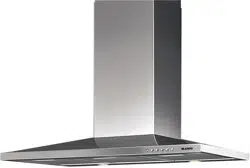Loading ...
Loading ...
Loading ...

re-use and recycling of this product, please contact your local authority or domestic waste collection service.
INSTALLATION INSTRUCTIONS
Any electrical work must be undertaken by a qualied electrician. It is dangerous to alter specications in any
way. Ensure that all packaging, both inside and outside the oven, has been removed before it is used.
After installation, please dispose of the packaging with due regard to safety and the environment.
Warnings for Installation:
a) The exhaust air must not be discharged into a ue which is used for exhausting fumes from appliances burn-
ing gas or other fuels.
b) The minimum distance from the hob surface and the lowest part of the range hood must not be less than
60cm. If the instructions for the hob specify a greater distance, please consider this.
c) The regulations concerning the discharge of exhaust air have to be fullled.
• Electric Connection
The appliance has been manufactured as a class II, therefore no earth cable is necessary.
The connection to the mains is carried out as follows:
BROWN = L line
BLUE = N neutral
If not provided, connect a plug for the electrical load indicated on the rating label. Where a plug is provided,
the cooker hood must be installed in order that the
plug is easily accessible.
An omnipolar switch with a minimum opening of 3mm between contacts, in line with the electrical load and
local standards, must be placed between the appliance and the network in the case of direct connection to
the electrical network.
If a connection tube composed of two parts is used, the upper part must be placed outside the lower part.
Do not connect the rangehood exhaust to the same conductor used to circulate hot air or for evacuating fumes
from other appliances generated by other than an electrical source.
Before proceeding with the assembly operations, remove the anti-grease lter(s) (Fig.6) so that the unit is easier
to handle.
In the case of assembly of the appliance in the suction version prepare the hole for evacuation of the air.
• We recommend the use of an air exhaust pipe with a diameter of 150. If a pipe with a smaller diameter is used,
the eciency of the product may be reduced and its operation may become noisier.
Warning: Failure to install the screws or xing device in accordance with these instructions
may result in electrical hazards (see technical data if supplied).
• Fixing to the wall
Depending on the installation use screws and screw anchors suited to the type of wall (e.g. reinforced concrete,
plasterboard, etc.). If the screws and screw anchors are provided with the product, check that they are suitable
for the type of wall on which the hood is to be xed.
Drill suitable holes A as per the dimension indicated (Fig.2) Fix the appliance to the wall and align it in hori-
zontally.
Secure the hood to the wall using screws A through the holes in the hood in the position shown (Fig.4).
• Fixing the decorative telescopic ue
Arrange the electrical power supply within the area of the decorative ue. If your appliance is to be installed
in the ducting version or in the version with external motor, prepare the air exhaust opening.
Adjust the width of the support bracket of the upper ue (Fig.3) x it to the wall using the screws A (Fig.3) so it
is in line with your hood and is 20 mm from the ceiling as indicated in Fig.2.
Connect the ange C to the air exhaust hole using a connection pipe (Fig.4). Insert the upper ue into the lower
ue and rest above the frame. Extract the upper ue up to the bracket and x it with the screws B (Fig.3).
To transform the hood from a ducting version to re-circulating, please follow the instructions below. Charcoal
lters are available as an optional extra.
Loading ...
Loading ...
Loading ...
